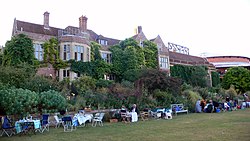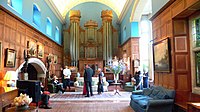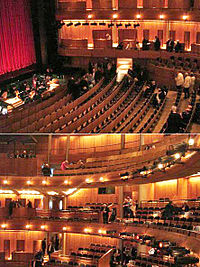Glyndebourne
| Glyndebourne Manor House | |
| Sussex | |
|---|---|
 Glyndebourne Manor House and auditorium | |
| Location | |
| Grid reference: | TQ45291079 |
| Location: | 50°52’42"N, 0°3’50"E |
| Village: | Glynde |
| History | |
| Country house | |
| Information | |
Glyndebourne is a country house in Sussex and the site too of an opera house that, since 1934, has been the venue for the annual Glyndebourne Festival Opera. The house, located near Lewes, is thought to be about six hundred years old and is a Grade II listed building.[1][2][3]
Contents
History of the house
"There had been a manor house at Glynde Bourne (as it was often spelt) since the fifteenth century",[1] but the exact age of the house is unknown. Some surviving timber framing and pre-Elizabethan panelling makes an early sixteenth-century date the most likely.[4] In 1618, it came into the possession of the Hay family, passing to James Hay Langham in 1824.[5][6] He inherited his father's baronetcy and estate in Northamptonshire in 1833 which under the terms of his inheritance should have led to him relinquishing Glyndebourne, but as a certified lunatic he was unable to do so. After litigation the estate passed to a relative, Mr Langham Christie, but he later had to pay £50,000 to persuade another relative to withdraw a rival claim.
Langham Christie's son, William Langham Christie, made substantial alterations to the house in the 1870s. First, a brick extension hid its seventeenth-century facade, while ornate stonework and balustrading was added. Then, in 1876, the architect Ewan Christian was engaged to install bay windows and add decorative brickwork to give the house the 'Jacobethan' appearance which can still be seen from the gardens today. Some of the exterior of the older parts of the house can be seen from the driveway next to the theatre.
Origins of the opera house
John Christie obtained the use of the house in 1913 after the death of William Langham Christie, his grandfather.[7] He came into full legal possession of the estate in 1920. Among other renovations, he added to the house an organ room, 80 feet long, in the process almost doubling the length of the south facade of the house. This room contained one of the largest organs outside of a cathedral in the country, built by the firm of Hill, Norman & Beard Ltd (bought by Christie in 1923). After the Second World War, John Christie made a gift of sections of the soundboards, pipes and structural parts to the rebuilt Guards Chapel, Wellington Barracks (which had been destroyed in the Blitz); the case and console remain at Glyndebourne.
John Christie's fondness for music led him to hold regular amateur opera evenings in this room. At one of these evenings in 1931, he met his future wife, the Sussex-born Canadian soprano Audrey Mildmay, a singer with the Carl Rosa Opera company who had been engaged to add a touch of professionalism to the proceedings.[8] They were married on 4 June 1931.[9] During their honeymoon, they attended the Salzburg and Bayreuth festivals, which gave them the idea of bringing professional opera to Glyndebourne, although Christie's original concept was for it to be similar to the Bayreuth Festival.[10] As their ideas evolved, the concept changed to focus on smaller-scale productions of operas by Mozart more suited to the intimate scale of the planned theatre.
The first theatre
As an annex to the organ room, the Christies built a fully equipped and up-to-date theatre with a 300-seat auditorium and an orchestra pit capable of holding a symphony orchestra.
Christie engaged conductor Fritz Busch as the first music director, Carl Ebert, the Intendant of Berlin's Städtische Oper as artistic director, and Rudolf Bing became general manager until 1949. All three men were exiles from Nazi Germany.
After extensive rehearsals, the first six-week season opened on 28 May 1934 with a performance of Le nozze di Figaro followed by Così fan tutte. Boyd Neel had conducted the first music heard in the renovated Glyndebourne opera house in 1934, in private performances, at John Christie's invitation.[11]
John Christie's original theatre was soon enlarged and improved many times after its initial construction. As early as 1936 its capacity was increased to 433; by 1952 it held nearly 600, and finally, in 1977, it held 850 people. In addition, a rehearsal hall was constructed.
Productions were interrupted by the Second World War, during which time the house became an evacuation centre for children from London. After 1945 the Festival slowly began again. Until 1951, the entire burden of financing the opera festival was undertaken by John Christie himself, but, in 1952, the Glyndebourne Festival Society was formed to take over the financial management. Christie's death in 1962 resulted in his son George (later Sir George) taking over, and additional changes and improvements to the theatre continued.[12]
Hill, Norman and Beard built the pipe organ in 1924, and it gradually expanded over the years. John Christie owned a considerable share in the company. Currently, the organ is a gutted shell, the pipes having been donated to various churches for the construction of new organs after Second World War. The organ originally contained 4 manuals and 46 stops, but this was eventually expanded to 106 stops, unusual for an English-built organ in having multiple diapason chorus ranks of pipes.
A short semi-documentary film was made in 1955 entitled On Such a Night, featuring excerpts from that year's production of Le nozze di Figaro and with glimpses of John Christie, Vittorio Gui and Carl Ebert, interwoven with fictional story about an American going there for the first time.[13]
The present theatre
By the late 1980s the theatre's expansion, which had proceeded in a somewhat piecemeal fashion, included an agglomeration of outbuildings which housed restaurants, dressing rooms, storage and other facilities. It became clear to George Christie that a completely new theatre - and not just an enlargement of the old one - was necessary. Having chosen the architects Michael and Patty Hopkins of Hopkins Architects in a design competition, Christie announced in 1990 that a new theatre, capable of seating 1,200 people, would be constructed in 1992.
The old theatre hosted its last festival in 1992, and construction of a brand-new 1,200-seat theatre was under way.[14] It was completed at a cost of £34 million, 90 per cent of which was raised through donations, which gave the donors control of 28% of the seats. The inaugural performance in the new theatre on 28 May 1994, given sixty years to the day after the old theatre's first performance, was Le nozze di Figaro.[15]
The design of the theatre, a large brick oval building, has resulted in a four-level, horseshoe-shaped auditorium with main level seating, two balconies, and a gallery topped with a circular roof. The over sixty-foot-high stage building is semi-circular in shape and allows for the efficient flying and storage of scenery. The acoustics, by Derek Sugden and Rob Harris of Arup Acoustics, have received praise.[16]
Outside links
| ("Wikimedia Commons" has material about Glyndebourne) |
- Glyndebourne Festival Opera
- An oral history of Glyndebourne opera - sound recordings of interviews with gardeners, musicians and staff.
- Julian Rhodes, "British Residence Organs of the Romantic Zenith", Julian Rhodes' Dream Organs blog
- David Pickard, "A Seasonal message from David Pickard, General Director". Glyndebourne Festival Opera, 13 December 2011
References
- ↑ 1.0 1.1 Kennedy, p. 5
- ↑ National Heritage List 1353005: Glyndebourne (Grade II listing)
- ↑ Christiansen, Rupert (2016-02-18). "Glyndebourne: the love story that started it all" (in en-GB). The Telegraph. SSN 0307-1235. https://www.telegraph.co.uk/opera/what-to-see/glyndebourne-the-love-story-that-started-it-all/.
- ↑ Kennedy, p. 6, notes in a caption of a 1756 watercolour: "The original fifteenth century house is almost hidden behind the imposing addition"
- ↑ Kay, John E. (1987). "The Glyndebourne Legend". Sussex Archaeological Collections 125: 256–257. https://archaeologydataservice.ac.uk/catalogue/adsdata/arch-285-1/dissemination/pdf/Vol_125_1987/SAC125_AH_Notes.pdf.

- ↑ Oxford, Edward Harley, Earl of (1998). Tory and Whig : the parliamentary papers of Edward Harley, 3rd Earl of Oxford, and William Hay, M.P. for Seaford, 1716-1753. Taylor, Stephen, Jones, Clyve, and Parliamentary History Yearbook Trust. Suffolk: Boydell Press. pp. xix. ISBN 0-85115-589-8. OCLC 36908855.
- ↑ Grant, Richard E. (2012-06-20). "Summer arts: An operatic journey" (in en-US). https://www.prospectmagazine.co.uk/magazine/swaziland-glyndebourne-janacek-opera-richard-e-grant.
- ↑ Kennedy, p. 7
- ↑ Kennedy, Michael. (2019). Glyndebourne : a short history.. Aries, Julia.. SHIRE PUBLICATIONS. ISBN 978-1-78442-422-0. OCLC 1099567585.
- ↑ Susan Aspen, "Pastoral Retreats: Playing at Arcadia in Modern Britain", Susan Aspen, ed., Operatic Geographies: The Place of Opera and the Opera House, Chicago University Press, 2019, 195-212, p. 201.
- ↑ The Gramophone, July 1972, p. 178
- ↑ Dickie, Brian (2014-05-10). "Remembering Sir George Christie (1934-2014) | The Arts Desk". https://theartsdesk.com/opera/remembering-sir-george-christie-1934-2014.
- ↑ Milnes, Rodney. 'On Such A Night' - Rodney Milnes rediscovers a Glyndbourne gem. Opera, 2010 Festivals Issue, page 44-47.
- ↑ Kennedy, Michael, 1926-2014 (15 August 2013). The Oxford dictionary of music. Kennedy, Joyce Bourne,, Rutherford-Johnson, Tim (Sixth ed.). Oxford. pp. 337. ISBN 978-0-19-957854-2. OCLC 841671917.
- ↑ Kennedy, p. 50
- ↑ Anthony Lewis (1994-07-11). "At Home Abroad; To Love and Be Wise". New York Times. https://www.nytimes.com/1994/07/11/opinion/at-home-abroad-to-love-and-be-wise.html.
- Allison, John (ed.), Great Opera Houses of the World, supplement to Opera magazine, London 2003
- Beauvert, Thierry, Opera Houses of the World, The Vendome Press, New York, 1995. ISBN 0-86565-978-8
- Binney, Marcus, and Rosy Runciman, Glyndebourne - Building a Vision, London: Thames and Hudson, 1994. ISBN 0-500-27754-0
- Hughes, Spike, Glyndebourne, London: Methuen, 1965.
- Kennedy, Michael, Glyndebourne; A Short History, Oxford: Shire Publications, 2010 ISBN 978-0-7478-0821-3
- Nairn, Ian; Nikolaus Pevsner (1965). Sussex (Buildings of England series). London: Penguin Books.
- Norwich, John Julius, Fifty Years of Glyndebourne, London: Jonathan Cape, 1985. ISBN 0-224-02310-1
- Plantamura, Carol, The Opera Lover's Guide to Europe, New York: Citadel Press, 1996. ISBN 0-8065-1842-1
- Zeitz, Karyl Lynn, Opera: the Guide to Western Europe's Great Houses, Santa Fe, New Mexico: John Muir Publications, 1991. ISBN 0-945465-81-5


